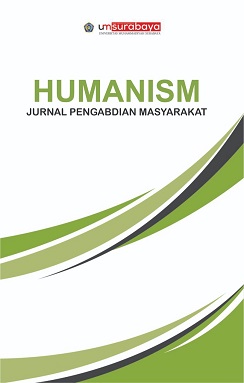Peningkatan Pengetahuan Pemanfaatan Toga Penderita Gangguan Jiwa Pada Panti Rehabilitasi Mental Al-Hafizh, Sidoarjo
DOI:
https://doi.org/10.30651/hm.v4i3.20220Abstrak
Penggunaan tanaman obat telah banyak digunakan untuk terapi alternatif bagi penderita gangguan jiwa. Tanaman obat termasuk juga buah dan sayur dapat digunakan untuk membantu memperbaiki kondisi kerusakan otak pada penderita gangguan neuropsikiatri sehingga dapat meningkatkan kualitas hidup penderitanya. Panti Rehabilitas Mental Al-Hafizh Sidoarjo dihuni oleh 29 pasien yang seluruhnya merupakan penderita skizofrenia. Di Panti tersebut memiliki beberapa program dan kegiatan, diantaranya adalah program pemulihan kesehatan jiwa dan program kemandirian rehabilitasi. Untuk itu kegiatan pengabdian masyarakat yang dilakukan ini bertujuan untuk memberdayakan para penderita gangguan jiwa di Panti rehabilitasi mental Al-Hafizh Sidoarjo untuk dapat mengenal tanaman obat, sayur dan buah yang dapat dikonsumsi sehari-hari. Kegiatan dilakukan pengenalan tanaman obat, buah dan sayur yang dapat dikonsumsi untuk pemulihan kesehatan mereka. Dari kuesionair pretest dan posttest menunjukkan adanya peningkatan pemahaman para peserta sebesar 47 – 60%.
Referensi
Ak T, Gulcin I, 2008. Antioxidant and radical scavenging properties of curcumin. Chemico-Biological Interactions, 174, 27–37.
Ambriz- Pérez Dulce L, et al., (2016), Phenolic compounds: Natural alternative in inflammation treatment. A Review. Cogent Food & Agriculture, 2: 1131412
Arruda APN, Zhang Y,Gomaa H, et al. ,2019. Herbal medications for anxiety, depression, pain, nausea and vomiting related to preoperative surgical patients: a systematic review and meta-analysis of randomized controlled trials. BMJ Open9:e023729.
Batiha,Gaber El-Saber; et al, 2020, The Pharmacological Activity, Biochemical Properties, and Pharmacokinetics of the Major Natural Polyphenolic Flavonoid: Quercetin, Foods9, 374;
Dong S, Zeng Q, Mitchell E.S, Xiu J, Duan Y, Li C, Tiwari J.K, Hu Y, Cao X, Zhao Z, 2012. Curcumin enhances neurogenesis and cognition in aged rats: Implications for transcriptional interactions related to growth and synaptic plasticity. PLoS ONE 7(2): e31211.
Gqaleni, N., Moodley, I., Kruger, H., Ntuli, A., & McLeod, H. (2007). Traditional and Complementary Medicine. South Africa Health Review, 12, 175–188
Gureje, O; Nortje, G., Makanjuola, V., et al. (2015). The role of global traditional and complementary systems of medicine in treating jiwa health problems. Lancet Psychiatry, 2(2), 168–177.
Hanapi NA, Yusof SR, Adenan MI et al. 2016, Blood-brain barrier permeability studies of Centella asiatica extract as potential neuroprotective agent, 14th Meeting of the Asian-Pacific Society for Neurochemistry, Kuala Lumpur, Malaysia, 27 Aug - 30 Aug.
Hashim P, Sidek H; Helan M. et al, 2011, Triterpene Composition and Bioactivities of Centella asiatica, Molecules, 16, 1310-1322.
Hurley L.L, Akinfiresoye L, Nwulia E, et al. 2013. Antidepressant-like effects of curcumin in WKY rat model of depression is associated with an increase in hippocampal BDNF. Behav Brain Res., 15(239), 27–30.
Kamelia, Emma, 2017, The Effect of Leaf Extract of Centella Asiatica on Neurogenesis and Bdnf Level in Hippocampus Cell Culture in Young Mice, Clinical Neurology and Neuroscience, p. 1 (1), 14 – 19.
Legiawati,L.; Fadilah,F.; Bramono, K. and Indriatmi, W., 2018, In silico Study of Centella asiatica Active Compounds as Anti-Inflammatory Agent by Decreasing Il-1 And Il-6 Activity, Promoting Il-4 Activity, J. Pharm. Sci. & Res. Vol. 10(9), 2142-2147
Mahboubi, Mohaddese, 2019, Zingiber officinale Rosc. essential oil, a review on its composition and bioactivity, Clinical Phytoscience, 5:6
Maramis, R. 2010. Buku Saku Diagnosis Gangguan Jiwa (PPDGJ III). Jakarta: FK Unika Atmajaya.
Nurlaily A, Noor Baitee AR, Musalmah M, 2012, Comparative Antioxidant and Anti-inflammatory Activity of Different Extracts of Centella asiatica (L.) Urban and Its Active Compounds, Asiaticoside and Madecassoside, Med & Health; 7(2): 62-72
Rahul; Naz, Falaq; Jyoti, Smita and Siddique, Yasir Hasan, 2020, Effect of kaempferol on the transgenic Drosophila model of Parkinson’s disease, Scientific Reports) 10:13793
Reza Pashaei (2016) Features of Apigenin, Luteolin, Hesperetin and Naringenin in Crop and Body. Int J Food Sci Nutr Diet. 5(5), 300-304.
Salehi B, Venditti A, Sharifi-Rad M, et al. 2019, The Therapeutic Potential of Apigenin, Int. J. Mol. Sci., 20, 1305
Sharifuldin, Munira binti Mohd Amin, 2014, Profiling and Quantification of Cosmos caudatus Kunth and Centella asiatica linn. and in vitro anti cancer activity of Cosmos caudatus, Thesis submitted in fulfilment of the requirements for the degree of Master of Science, September
Simon A, Darcsi A, Kéry A et al. 2020, Blood-brain barrier permeability study of ginger constituents, Journal of Pharmaceutical and Biomedical Analysis, Volume 177, 5 January, 112820
Singh SK, Patel JR and Bachle D. 2014, a Review on Zingiber officinale: a Natural Gift, Int J Pharm Bio Sci, July ; 5 (3) : (P) 508 – 525
Umar MI, Asmawi MZ, Sadikun A, et al., 2012, Bioactivity-Guided Isolation of Ethyl-p-methoxycinnamate, an Anti-inflammatory Constituent, from Kaempferia galanga L. Extracts, Molecules, 17, 8720-8734;
Yadav R, Jee B, Awasthi Su.K, 2015. Curcumin suppresses the production of pro-inflammatory cytokine interleukin-18 in lipopolysaccharide stimulated murine macrophage-like cells. Ind J Clin Biochem., 30(1), 109–112.
Yao F; Zhu X; Wang Y and He, 2018, Xiangjiu, Phenolics from the Rhizomes of Kaempferia galanga L. and Their Antioxidant Activity, Journal of Complementary and Alternative Medical Research, 5(1): 1-6;

Unduhan
Diterbitkan
Terbitan
Bagian
Lisensi
Hak Cipta (c) 2023 Humanism : Jurnal Pengabdian Masyarakat

Artikel ini berlisensiCreative Commons Attribution-ShareAlike 4.0 International License.
Penulis yang menerbitkan jurnal perlu menyetujui beberapa persyaratan berikut:
1) Penulis memegang hak cipta dan memberikan hak jurnal untuk publikasi pertama dengan karya yang dilisensikan secara bersamaan di bawah Lisensi Atribusi Creative Commons yang memungkinkan orang lain untuk membagikan karya tersebut dengan pengakuan atas penulisan karya dan publikasi awal dalam jurnal ini.
2) Penulis dapat membuat pengaturan kontrak tambahan yang terpisah untuk distribusi non-eksklusif dari versi jurnal yang diterbitkan dari karya tersebut (misalnya, mempostingnya ke penyimpanan institusional atau menerbitkannya dalam sebuah buku), dengan pengakuan atas publikasi awalnya di jurnal ini.
3) Penulis diizinkan dan didorong untuk memposting karya mereka secara online (misalnya, di repositori institusional atau di situs web mereka) sebelum dan selama proses pengiriman, karena hal itu dapat mengarah pada pertukaran yang produktif, serta kutipan yang lebih awal dan lebih besar dari karya yang diterbitkan.




